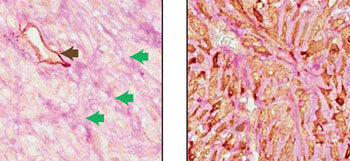Macrophages Form Vascular Mimicry Channels to Supply Growing Tumors
By Gerald M. Slutzky, PhD
Posted on 22 Nov 2016
A potential new therapeutic approach to block cancer development is based on the finding that macrophages form primitive non-endothelial “vessels” or vascular mimicry channels that help supply growing tumors with oxygen and nutrients.Posted on 22 Nov 2016
Vascular mimicry has been observed in several types of solid tumors, including glioblastoma, breast cancer, and melanoma, and has been attributed to a sub-population of cells within the tumor called cancer stem cells. Macrophages, key cells of the innate immune system, are known to support vascular development but were not believed to directly form vessel walls. New evidence has changed this concept, as investigators at the Scripps Research Institute (La Jolla, CA, USA) reported in November 11, 2016, online edition of the journal Scientific Reports that they had found that macrophages structurally formed primitive vascular mimicry (VM) channels in both tumor and angiogenesis in vivo models. These channels, which were lined with cells that expressed macrophage cell surface markers, were functionally connected to the systemic vasculature, as they were perfused by intravenously injected dye.

Image: Two adjacent sections of a mouse breast tumor. Tissue at left is stained so that normal blood vessels can be seen (black arrow). Extending from these vessels are blood filled channels (green arrows). On the right, the tissue is stained for a fluorescent protein expressed by the tumor cells. Here it is seen that blood-filled channels are actually formed by tumor cells in a process known as vascular mimicry (Photo courtesy of Cold Spring Harbor Laboratory).
Since both models shared hypoxic micro-environments, the investigators hypothesized that hypoxia may be an important mediator of VM formation. Indeed, results showed that conditional genetic depletion of myeloid-specific HIF-1alpha (hypoxia inducible factor-1 alpha) resulted in decreased VM network formation, dye perfusion, and tumor size. The VM channels appeared to be too small to transport red blood cells, but the researchers suggested that the low oxygen concentrations within tumors drove macrophages to form this network of channels to transport dissolved oxygen and glucose.
"This may represent a whole new therapeutic target for treating tumors,” said senior author Dr. Martin Friedlander, a research professor at the Scripps Research Institute.
Related Links:
Scripps Research Institute













